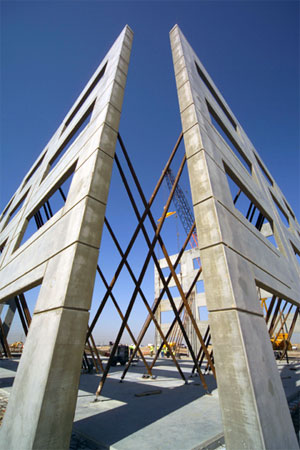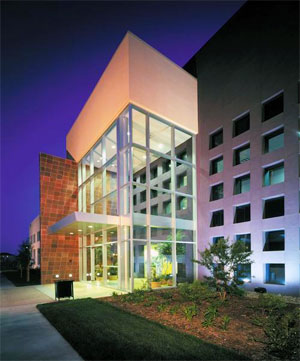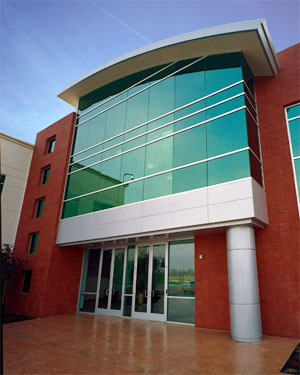Frequently Asked Questions
Financial Benefits | Environmental Benefits | Safety & Convenience
Construction | Durability | Aesthetics| FAQs
1. What is the typical thickness of a panel?

The minimum thickness for commercial walls is generally 5½ inches, with 7¼ inches the most typical thickness (reinforced with 1.3 to 2.5 psf of reinforcing).
2. What is the minimum-size building that is economical?
Some as small as 5,000 square feet can be economical, if they are relatively tall. Several small buildings clustered together may also prove economical. Special finishes on the walls, such as exposed aggregate or form liners, may make Tilt-Up an economical choice.
3. What is the minimum-height building that is economical?
Panels up to 96 feet in height have been used in some areas, but special cranes and spreader bars are required for panels over 30 feet in height. It is generally better to have the panels all nearly the same height and less than 30 feet.
4. Is there any limit to the number or location of panel openings?
There is no real limit to the number or location of openings, but their locations can be critical. Openings closer than the minimum distance from the end of the panel supporting a concentrated roof load can add considerable reinforcing, thickened concrete or steel columns. The minimum distance is one-eighth the eave height or two feet, whichever is less.
5. What size crane is needed to lift the panel?
It is best to let the crane company determine this, based on the size and weight of panels involved. A rule of thumb for the size, however, is two to three times the weight of the panel.

6. Are there any site conditions that limit tilt-up construction?
Yes, the following should be considered:
![]() Access by the crane to the job site.
Access by the crane to the job site.
![]() Relatively flat terrain for the crane's operation.
Relatively flat terrain for the crane's operation.
![]() The presence of any power lines, ditches, railroad tracks, or other obstructions which limit crane operation.
The presence of any power lines, ditches, railroad tracks, or other obstructions which limit crane operation.
![]() The presence of other buildings very close to where panels must be placed.
The presence of other buildings very close to where panels must be placed.
7. What really holds the tilt-up panels in place?
The roof structure acts as a diaphragm to horizontally support the wall at the top, and the curb on the footing supports it laterally at the bottom. The panels are generally not connected together in order to allow for expansion and contraction without cracking. The panels are only positively connected to the roof at their centers near the top.
8. What information is needed to bid a building, and how long does it take?
With the preliminary floor plan, desired height, wall finishes, mansards, roof type, preliminary soil report, and building code jurisdiction, it may be permitted to be completed in a week.
9. What information is needed to design and detail a building, and how long does it take?
The finalized floor plan, soil report, and decisions on all the bid options are needed, along with any planning commission requirements. With this information, the design and detailing for plans to submit to the building department will take a minimum of four weeks.
10. How do you insulate a tilt-up wall?
 Tilt-Up, much like most structural envelopes, can receive insulation on the inside through the use of furring systems, or on the outside with EIFS. However, the most effective method of insulating Tilt-Up walls is known as the "sandwich" method. This involves placing a layer of insulation between a structural concrete layer and an architectural or non-structural concrete layer during the casting of the panel, and then tilting this entire construction as a panel. This method is made possible by structurally connecting the two concrete layers through the insulation layer. As soon as the panel is erected to its final position, the inside layer becomes structural and load-bearing, while the outer concrete layer is suspended from it to allow for temperature changes without cracking. It is critical that these two layers remain independent from each other with the exception of the connection through the insulation. TCA Member Companies that supply these sandwich systems include Composite Technologies Corporation and Owens Corning.
Tilt-Up, much like most structural envelopes, can receive insulation on the inside through the use of furring systems, or on the outside with EIFS. However, the most effective method of insulating Tilt-Up walls is known as the "sandwich" method. This involves placing a layer of insulation between a structural concrete layer and an architectural or non-structural concrete layer during the casting of the panel, and then tilting this entire construction as a panel. This method is made possible by structurally connecting the two concrete layers through the insulation layer. As soon as the panel is erected to its final position, the inside layer becomes structural and load-bearing, while the outer concrete layer is suspended from it to allow for temperature changes without cracking. It is critical that these two layers remain independent from each other with the exception of the connection through the insulation. TCA Member Companies that supply these sandwich systems include Composite Technologies Corporation and Owens Corning.
11. What is the fire resistance of a tilt-up panel?
The fire resistance of Tilt-Up walls is easily referenced and/or calculated in the current UBC and IBC codes. Fire resistance is related to an R rating that determines time duration based on the thickness and type of material. Whether a solid concrete panel or an insulated sandwich panel, Tilt-Up fire resistance can be determined with little effort. The following table is from the data contained in both the UBC and IBC codes. It shows the relative thickness required for each aggregate type to meet the listed fire resistance rating.
Fire Resistance of Single-Layer Concrete Walls(UBC/IBC Tables)
|
||||||||||||||||||||||||
For more information on fire rating Tilt-Up concrete panels, order the TCA Fire Resistance Reference Topic.
Additional references can be found in Concrete Technology Today from the PCA in Vol. 23 No. 1 [458KB pdf] on page 4 and in Vol. 24 No. 3 [745KB pdf] on page 5.


